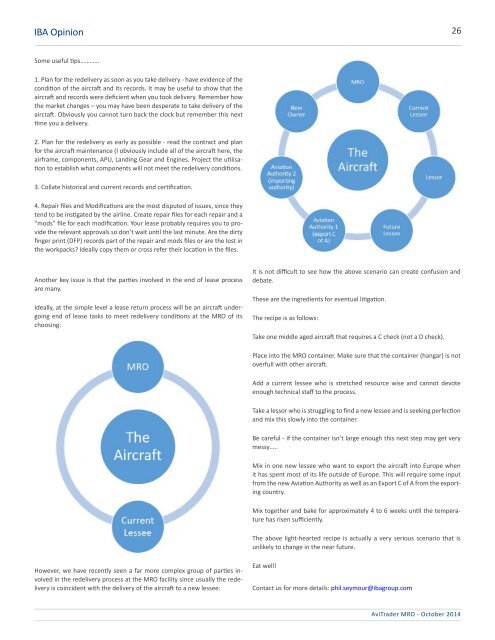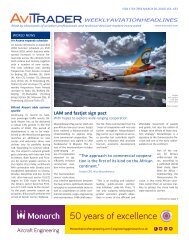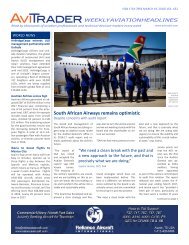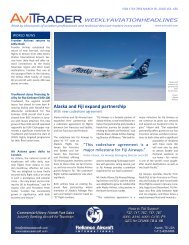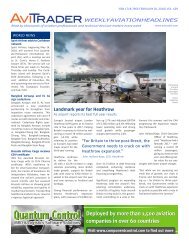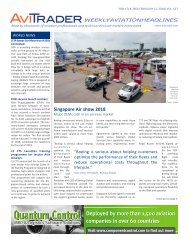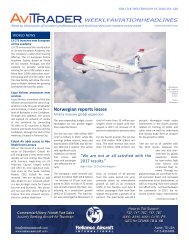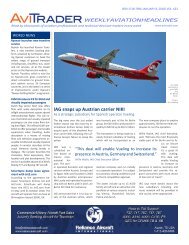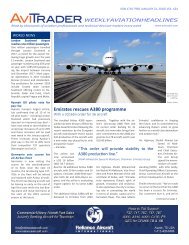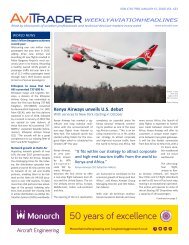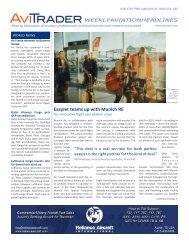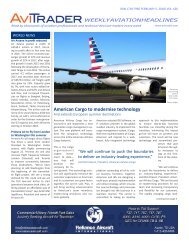AviTrader_Monthly_MRO_e-Magazine_2014-10
AviTrader_Monthly_MRO_e-Magazine_2014-10
AviTrader_Monthly_MRO_e-Magazine_2014-10
You also want an ePaper? Increase the reach of your titles
YUMPU automatically turns print PDFs into web optimized ePapers that Google loves.
IBA Opinion<br />
26<br />
Some useful tips…………<br />
1. Plan for the redelivery as soon as you take delivery - have evidence of the<br />
condition of the aircraft and its records. It may be useful to show that the<br />
aircraft and records were deficient when you took delivery. Remember how<br />
the market changes – you may have been desperate to take delivery of the<br />
aircraft. Obviously you cannot turn back the clock but remember this next<br />
time you a delivery.<br />
2. Plan for the redelivery as early as possible - read the contract and plan<br />
for the aircraft maintenance (I obviously include all of the aircraft here, the<br />
airframe, components, APU, Landing Gear and Engines. Project the utilisation<br />
to establish what components will not meet the redelivery conditions.<br />
3. Collate historical and current records and certification.<br />
4. Repair files and Modifications are the most disputed of issues, since they<br />
tend to be instigated by the airline. Create repair files for each repair and a<br />
“mods” file for each modification. Your lease probably requires you to provide<br />
the relevant approvals so don’t wait until the last minute. Are the dirty<br />
finger print (DFP) records part of the repair and mods files or are the lost in<br />
the workpacks? Ideally copy them or cross refer their location in the files.<br />
Another key issue is that the parties involved in the end of lease process<br />
are many.<br />
Ideally, at the simple level a lease return process will be an aircraft undergoing<br />
end of lease tasks to meet redelivery conditions at the <strong>MRO</strong> of its<br />
choosing:<br />
It is not difficult to see how the above scenario can create confusion and<br />
debate.<br />
These are the ingredients for eventual litigation.<br />
The recipe is as follows:<br />
Take one middle aged aircraft that requires a C check (not a D check).<br />
Place into the <strong>MRO</strong> container. Make sure that the container (hangar) is not<br />
overfull with other aircraft.<br />
Add a current lessee who is stretched resource wise and cannot devote<br />
enough technical staff to the process.<br />
Take a lessor who is struggling to find a new lessee and is seeking perfection<br />
and mix this slowly into the container.<br />
Be careful - if the container isn’t large enough this next step may get very<br />
messy…..<br />
Mix in one new lessee who want to export the aircraft into Europe when<br />
it has spent most of its life outside of Europe. This will require some input<br />
from the new Aviation Authority as well as an Export C of A from the exporting<br />
country.<br />
Mix together and bake for approximately 4 to 6 weeks until the temperature<br />
has risen sufficiently.<br />
The above light-hearted recipe is actually a very serious scenario that is<br />
unlikely to change in the near future.<br />
However, we have recently seen a far more complex group of parties involved<br />
in the redelivery process at the <strong>MRO</strong> facility since usually the redelivery<br />
is coincident with the delivery of the aircraft to a new lessee:<br />
Eat well!<br />
Contact us for more details: phil.seymour@ibagroup.com<br />
<strong>AviTrader</strong> <strong>MRO</strong> - October <strong>2014</strong>


